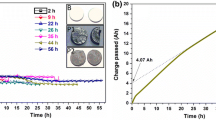Abstract
In terms of the model of steady-state process of a refractory-metal ion secondary reduction with an alkali (or alkali-earth) metal formed on a smooth cathode during salt melt electrolysis, numerical reproducing of a natural experiment is carried out. The model calculations are based on the polarization measured during the cathodic reduction of Nb in chloride―fluoride melt: [Nb] = 2.4 mol %, 800°C, current density i up to 5.4 A/cm2. On a smooth cathode in the overvoltage range from 0.21 to 0.41 V (i = 0.75―1.17 A/cm2), the reduction mechanism is shown to completely change from primary to the secondary reduction. The secondary reduction zone is located inside the diffusion layer and moves away from the cathode with increasing i. Even at maximal i, this zone remains inside δ (δ is the thickness of the diffusion layer): with i = 0.96 A/cm2, the coordinate of the maximum of the secondary reduction rate xm = 0; with i = 5.4 A/cm2, xm = 0.93δ (in the experiment, the value of i at which xm ≥ δ was not achieved). At i = 5.4 A/cm2, the fraction of secondary reduction in the bulk is insignificant, ≈10−5 A/cm2. The δ vs. E curve is calculated: when E is shifted from the equilibrium value toward the negative values, |i| increased from zero and higher, whereas δ first decreased by an order of magnitude and then increased. Correspondingly, the limiting diffusion current is not constant at a constant Nb concentration in the bulk. This is the reason of uncertain limiting current on steady-state cathodic polarization curves during the electrolysis of metals in melts. A hypothesis is proposed on the dependence of the Nernst diffusion layer thickness near the cathode on the current density exceeding the limiting diffusion current density under the conditions of secondary reduction.




Similar content being viewed by others
REFERENCES
Khramov, A.P., Chernyshev, A.A., Isakov, A.V., and Zaykov, Yu.P., Secondary reduction of a refractory metal near a smooth cathode during electrolysis of molten salt. 1. Derivation of basic equations for the process model, Russ. J. Electrochem., 2020, vol. 56, no. 9.
Khramov, A.P., Chernyshev, A.A., Isakov, A.V., and Zaykov, Yu.P., Secondary reduction of a refractory metal near a smooth cathode during electrolysis of molten salt. 2. Calculations for some hypothetical experiments, Russ. J. Electrochem., 2020, vol. 56, no. 9.
Lukinskikh, A.V., Electrode processes during the electrolysis of tantalum and niobium from chloride-fluoride melts. Cand. Sci. Chem. Dissertation, Yekaterinburg: Inst. Electrochem., Akad. Nauk SSSR, 1986.
Smirnov, M.V., Chebykin, V.V., and Tsiovkina, L.A., The thermodynamic properties of sodium and potassium dissolved in their molten chlorides, bromides, and iodides, Electrochim. Acta, 1981, vol. 26, no. 9, p. 1275. https://doi.org/10.1016/0013-4686(81)85111-0
Smirnov, M.V., Electrode Potentials in Molten Chlorides (in Russian), Moscow: Nauka, 1973, p. 212–215.
Kovalevsky, P.A. and Chebykin, V.V., Transport characteristics of reduced forms of solvent cations in melts of alkali metal chlorides, Rasplavy (in Russian), 1992, no. 3, p. 36.
Levich, B.G., Physico-chemical Hydrodynamics, Englevood-Cliffs, NJ: Prentice-Hall, 1962.
Pleskov, Yu.V. and Filinovsky, V.Yu., Rotating Disc Electrode, New York: Consultants Bureau,1972.
Khramov, A.P., Nekrasov, V.N., and Ivanovskii, L.E., Experimental Study of Mass Transport to an Axially Vibrated Cylindrical Electrode. Measurements on of the Intensity of Mass Transport, Soviet Electrochem., 1990, vol. 26, p. 1151.
ACKNOWLEDGMENTS
Authors are grateful to A.V. Lukinskikh for the kindly granted information and valuable discussion concerning his work [3].
Author information
Authors and Affiliations
Corresponding authors
Ethics declarations
The authors declare that they have no conflict of interest.
Additional information
Translated by Yu. Pleskov
Rights and permissions
About this article
Cite this article
Khramov, A.P., Chernyshev, A.A., Isakov, A.V. et al. Secondary Reduction of Refractory Metal near Smooth Cathode during the Salt Melt Electrolysis. 3. Numerical Reproducing of Natural Experiment with the Nb Cathodic Reduction in KNaCl2–NaF–K3NbF7 Melt. Russ J Electrochem 56, 959–968 (2020). https://doi.org/10.1134/S102319352011004X
Received:
Revised:
Accepted:
Published:
Issue Date:
DOI: https://doi.org/10.1134/S102319352011004X




